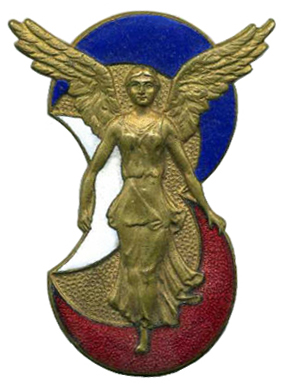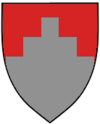
The 14th Armored Division was an armored division of the United States Army assigned to the Seventh Army of the Sixth Army Group during World War II. It remains on the permanent roll of the Regular Army as an inactive division, and is eligible for reactivation. The division is officially nicknamed the "Liberators".

The 709th Static Infantry Division was a German Army infantry division in World War II. It was raised in May 1941 and used for occupation duties during the German occupation of France in World War II until the Allied invasion. It was on the Normandy coast when the invasion occurred and so fought in the Battle of Normandy. The division was trapped in the Cotentin Peninsula and destroyed in the defense of Cherbourg.

The 91st Air Landing Division was a German Army infantry division in World War II.

The 9th Panzer Division was a panzer division of the German Army during World War II. It came into existence after 4th Light Division was reorganized in January 1940. The division was headquartered in Vienna, in the German military district Wehrkreis XVII.

The Ardennes Counteroffensive, commonly known as the Battle of the Bulge, was a massive military operation undertaken by Nazi Germany in southern Belgium and northern Luxembourg which lasted from 16 December 1944 until 25 January 1945. The intent of the offensive was to split the ground forces of the Western Allies from each other and encourage them to make peace with Germany, leaving all of Germany's military might to fight off the resurgent USSR.

The German 148th Reserve Division was a German reserve infantry formation during the Second World War. It was made up of three infantry regiments and an artillery regiment. Initially an occupation force in southern France, serving as a depot for rest and rifitting, it was activated as an infantry division and fought in Italy from 1944 to 1945. Redesignated the 148th Infantry Division in September 1944 to fight the allied invasion during Operation Dragoon, it later fought in the Po River battles, surrendering to the Brazilian Expeditionary Force on April 28, 1945, after being encircled in the Battle of Collecchio, near the city of Fornovo di Taro at Galano.

The 3rd Algerian Infantry Division was an infantry division of the Army of Africa which participated in World War II.

The 15th Infantry Division was an infantry division of the German Army during the interwar period and World War II, active from 1934 to 1945.

The 41st Infantry Division, formerly the 41st Fortress Division, was a German Army infantry division in World War II. It was employed on occupation duties in southern Greece, and surrendered to the Yugoslav partisans at the end of the war.
The 85th Infantry Division was a Wehrmacht division used in the Second World War. It participated in the German defence in the Battle of Normandy, and took part in the German counter-offensive in the Ardennes.

The 242nd Infantry Division was an infantry division of the German Army in World War II.

The Battle of Marseille was an urban battle of World War II that took place August 21–28, 1944, and led to the liberation of Marseille by Free French forces under the command of General Jean de Lattre de Tassigny. The groundwork was laid by the Allied invasion of southern France in Operation Dragoon on 15 August 1944 by the United States Seventh Army, with major support from the French First Army.

The Battle of Toulon was an urban battle of World War II in southern France that took place August 20–26, 1944 and led to the liberation of Toulon by Free French forces under the command of General Edgard de Larminat.
The 82nd Guards Rifle Division was reformed as an elite infantry division of the Red Army in March 1943, based on the 2nd formation of the 321st Rifle Division, and served in that role until after the end of the Great Patriotic War, including briefly in the Soviet Army.
The 59th Infantry Division(German: 59. Infanteriedivision) was a military division of the Wehrmacht during World War II.
The 159th Infantry Division was an infantry division of the German Heer during World War II. The unit, at times designated Commander of Reserve Troops IX, 159th Division, Division No. 159, and 159th Reserve Division, was active between 1939 and 1945.
The 180th Infantry Division was an infantry division of the German Heer during World War II. The unit, at times designated Commander of Reserve Troops X/II, 180th Division, Division No. 180, and Operation Division No. 180, was active between 1939 and 1945.
The 252nd Infantry Division was an infantry division of the German Heer during World War II.
The 416th Infantry Division was a German infantry division of World War II.
The 242nd Rifle Division was the lowest-numbered infantry division of the Red Army to be formed from scratch following the German invasion of the USSR. It was largely based on what would become the shtat of July 29, 1941 and was very quickly assigned to the new 30th Army of Western Front. Despite many shortages of equipment and specialist personnel, and a near-complete absence of formation training, the division joined the active army on July 15, thrown into the fighting near Smolensk. In late August and early September it took part on the Front's offensives toward Dukhovshchina, in an ultimately unsuccessful effort to encircle and destroy a large part of the German 9th Army. At the start of Operation Typhoon on October 2 it was defending part of the sector attacked by 9th Army and 3rd Panzer Group south of Bely and was quickly overwhelmed. After fighting in encirclement for most of the rest of the month its remaining men were able to break out and reach Soviet-held territory, but the losses were to too great to justify rebuilding and the division was disbanded.











